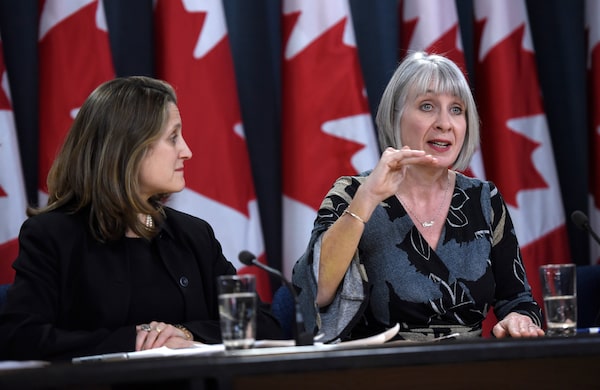
Deputy Prime Minister Chrystia Freeland listens as Minister of Health Patty Hajdu speaks during a press conference on COVID-19 at the National Press Theatre in Ottawa, on March 16, 2020.Justin Tang/The Canadian Press
Canada closed the border to non-American visitors, while Ontario asked owners to close bars and restaurants Monday as the federal government and provinces continued to leapfrog each other in a patchwork response to the coronavirus pandemic.
Confirmed cases of COVID-19 jumped from 313 on Sunday to 425 on Monday, prompting Deputy Prime Minister Chrystia Freeland to warn “this situation will get worse before it gets better.” British Columbia announced three new deaths, bringing the Canadian total to four.
Since serious containment measures to limit the spread of disease began last week, Prime Minister Justin Trudeau’s government and the 10 provinces have displayed widely divergent tactics, decision-making, timing and communication styles.
Ontario’s request that bars and restaurants close, hours after Premier Doug Ford and his province’s top health official said it wasn’t yet necessary, contrasts with the formal shutdown order Quebec issued to bars, while allowing restaurants to remain open. Bars are still open in B.C.
Ontario and Quebec closed schools last week and most other provinces have slowly followed suit this week, with Alberta shutting theirs indefinitely. B.C. was expected to make an announcement Tuesday.
Response has been uneven within provinces. Within Alberta, Calgary declared a state of emergency and restricted occupancy on most businesses, while Edmonton asked restaurant goers to keep their distance from each other.
Former federal health minister Jane Philpott said “there is cause for concern” in the inconsistency of public health messages across Canada.
“The risk associated with that is that Canadians get confused if there isn’t clear messaging, and there’s obviously a concern … that the virus will continue to spread in some areas,” said the medical doctor, recently named dean of Queen’s University’s faculty of health sciences and director of the school of medicine.
Still, she said the federal government is limited in its authority over health systems, and the chief public health officer is not able to compel actions by the provinces. However, she said there should be a clear message about the need for physical distancing that includes limits on the number of people in group settings and the temporary shutdown of non-essential businesses.
“You can’t go back in time and take stronger measures two days ago. You can only take stronger measures today,” Dr. Philpott said.
Meanwhile, Mr. Trudeau’s decision to restrict arrivals from overseas while allowing American visits to continue was the latest measure criticized as slow. Several premiers have called for the closing for a week or more and several airlines had already drastically cut international flights. Still, the Ontario and Quebec premiers welcomed the move. Quebec’s Premier François Legault said allowing Americans in with the 14-day quarantine was the right balance.
In 2018, Americans made 24.4 million visits to Canada while travellers from the rest of the world made 6.9 million visits.
B.C. Health Minister Adrian Dix, whose province sits next to the COVID-19 hot spot Washington State, denied there was a lack of proper communication with Ottawa, but he criticized that visitors from the U.S. were not also barred.
“We support the changes but we remain concerned that access from visitors from the United States continues to be allowed,” said Mr. Dix. “It’s our strong message that visitors from the United States not come to British Columbia. Don’t come.”
The government is in talks with the United States about border management. Canada’s approach could still change.
“The level of integration of our two countries is quite particular, which is why we need to do some more work in order to ensure that we’re doing what we need to do in the right way,” Mr. Trudeau said.
More important than the travel ban is what people in Canada, and those arriving, do right now to stop the spread of the virus and “shore up the domestic response,” Canada’s Chief Public Health Officer Theresa Tam said. That includes detecting cases, doing contact tracing, social distancing, and self-isolating. She said the border measures “add layers of protection on top of that fundamental public health action.”
Dr. Tam and federal Health Minister Patty Hajdu said co-ordination behind the scenes is happening at the political and technical levels. They noted that across Canada the minimum recommendation is to cancel events with more than 50 people.
But in the City of Ottawa the advice is more stringent, with officials recommending limits on groups to five people. Quebec’s ban limits gatherings to 250 people, although it followed up with stringent complete bans on recreational and community gatherings.
“While we provide national guidance there is actually a need to have a look at what the local and provincial contexts are,” Dr. Tam told reporters. Concerted action across Canada is needed, she said but it will be up to individual jurisdictions to decide what the social distancing will look like and what that means for businesses, work places, and other public areas.
After one-on-one calls with provincial counterparts over the weekend, Ms. Freeland said Ottawa would start holding regular meetings with all first ministers to “co-ordinate our national response.” And the federal government will now hold daily updates at noon ET, following the lead of several provinces.
In Quebec, the jurisdiction that has adopted among the quickest and more aggressive overall containment measures, Horacio Arruda, the provincial director of public health, drives decisions. Mr. Legault, who prides himself on decisiveness, has backed Dr. Arruda’s recommendations, some of which were surprising at first, like formal orders banning gatherings and closing an array of businesses, including bars.
With reports from Justine Hunter, Wendy Cox and James Keller.
Sign up for the Coronavirus Update newsletter to read the day’s essential coronavirus news, features and explainers written by Globe reporters.